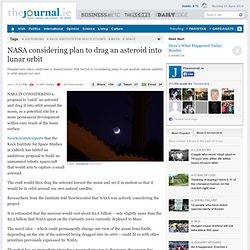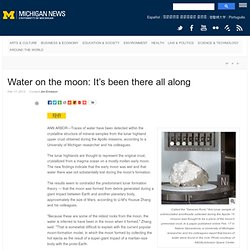

Is there any point to go back to the moon? Global Exploration Roadmap: Putting a Canadian on the moon. Peter Rakobowchuk, The Canadian Press Published Sunday, August 25, 2013 8:56AM EDT Last Updated Sunday, August 25, 2013 9:07AM EDT MONTREAL -- Canada could be sending its first astronaut to the moon under an ambitious long-term plan being developed by a group of space agencies around the world.

A return to the moon within the next two decades is part of the recently updated Global Exploration Roadmap -- a far-reaching plan developed by more than a dozen space agencies. Canada is among the 14 space agencies participating in the International Space Exploration Coordination Group, which first started developing the strategy in 2007. The first roadmap was released in 2011 and the latest update was made public last week. An early phase of the plan would put a new space station into orbit around the moon, and use it as a staging point to ferry astronauts back and forth. The CSA official suggested astronauts could again be moon-bound in about 15 years. Their specialty: robotics.
NASA considering plan to drag an asteroid into lunar orbit. NASA IS CONSIDERING a proposal to ‘catch’ an asteroid and drag it into orbit around the moon, as a potential site for a more permanent development within easy reach of the lunar surface.

NewScientist reports that the Keck Institute for Space Studies at Caltech has tabled an ambitious proposal to build an unmanned robotic spacecraft that would aim to capture a small asteroid. The craft would then drag the asteroid toward the moon and set it in motion so that it would be in orbit around our own natural satellite. Researchers from the Institute told NewScientist that NASA was actively considering the project. It is estimated that the mission would cost about $2.6 billion – only slightly more than the $2.5 billion that NASA spent on the Curiosity rover currently deployed to Mars. The novel idea – which could permanently change our view of the moon from Earth, depending on the site of the asteroid being dragged into its orbit – could fit in with other priorities previously expressed by NASA.
Giant Nasa spider robots could 3D print lunar base using microwaves. The first lunar base on the Moon may not be built by human hands, but rather by a giant spider-like robot built by Nasa that can bind the dusty soil into giant bubble structures where astronauts can live, conduct experiments, relax or perhaps even cultivate crops.

We've already covered the European Space Agency's (ESA) work with architecture firm Foster + Partners on a proposal for a 3D-printed moonbase, and there are similarities between the two bases -- both would be located in Shackleton Crater near the Moon's south pole, where sunlight (and thus solar energy) is nearly constant due to the Moon's inclination on the crater's rim, and both use lunar dust as their basic building material. However, while the ESA's building would be constructed almost exactly the same way a house would be 3D-printed on Earth, this latest wheeze -- SinterHab -- uses Nasa technology for something a fair bit more ambitious. Here's a video of it dancing, because science: One small hut for mankind: Blueprints unveiled for the first habitable moon base. Water on the moon: It’s been there all along. Called the "Genesis Rock," this lunar sample of unbrecciated anorthosite collected during the Apollo 15 mission was thought to be a piece of the moon's primordial crust.

In a paper published online Feb. 17 in Nature Geoscience, a University of Michigan researcher and his colleagues report that traces of water were found in the rock. Photo courtesy of NASA/Johnson Space CenterANN ARBOR—Traces of water have been detected within the crystalline structure of mineral samples from the lunar highland upper crust obtained during the Apollo missions, according to a University of Michigan researcher and his colleagues. The lunar highlands are thought to represent the original crust, crystallized from a magma ocean on a mostly molten early moon. The new findings indicate that the early moon was wet and that water there was not substantially lost during the moon's formation. "Under that model, the hot ejecta should have been degassed almost completely, eliminating all water," Zhang said.